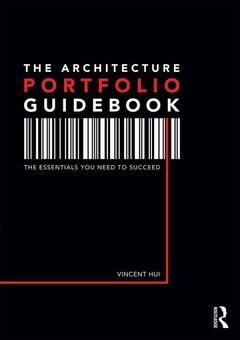The Architecture Portfolio Guidebook The Essentials You Need to Succeed
Auteur : Hui Vincent

The Architecture Portfolio Guidebook shows you how to make portfolios for both academic and professional needs to provide reviewers exactly what they are looking for. In school, architecture curricula nurture the knowledge and skills to develop design work to varying levels of presentation. In the profession, those skills are further developed and applied in the creation of the built environment. In both contexts, a portfolio is a core component for admission and advancement.
This book provides key strategies to:
? develop an understanding of the unique needs of professional and academic organizations;
? identify applicants? key differentiators;
? highlight how applicants present themselves in their portfolios to address institutional needs;
? create successful reinforcing documentation;
? communicate using portfolios.
Rather than proposing generic solutions, this book details the successful practices for portfolio creation by addressing portfolio creation academically and professionally. Supporting insights and examples from leading academics and architects from around the world reinforce the themes presented in this guidebook. An ideal read for students and professionals of architecture, landscape architecture, interior design, and urban design, looking to advance their studies and careers.
ACKNOWLEDGEMENTS
PREFACE
EXTERNAL PERSPECTIVE INTRODUCTIONS
1.0 WHAT ARE YOU TRYING TO DO?
1.1 Messaging, Media, and Methods
1.2 The Two Major Types of Portfolios
1.3 Showcasing Skill, Creativity, and Passion
1.4 Gathering, Archiving, Curating, and Editing
1.5 Planning, Scheduling, and Managing
2.0 IDENTIFYING YOUR KEY DIFFERENTIATORS
2.1 The Economics of Portfolio Design: Unique Value Proposition, Assets, and Commodities
2.2 Understanding Your Competition
2.3 Creativity and Critical Thinking
2.4 Technical Skills
2.5 Experience
2.6 Accomplishments
2.7 Passion
3.0 WHAT TO PRESENT IN A PORTFOLIO
3.1 Aligning Yourself with the Audience
3.2 The Balance: Design and Technical Skills
3.3 The Three Things Not to Show: Ignorance, Laziness, Pride
4.0 HOW TO PRESENT YOURSELF IN A PORTFOLIO
4.1 Layout and Imagery
4.2 Text
4.3 Interactive Media
5.0 PORTFOLIO PREPARATION: TARGETING AN AUDIENCE
5.1 Pacing
5.2 Passing the 30-second Flip Test: Impression, Expression, and Retention
5.3 Feedback and Refinement
6.0 THE PORTFOLIO AS A SUCCESSFUL REINFORCING DOCUMENT
6.1 Letters: Cover Letter and Letter of Intent
6.2 Resumé/CV: Outline of Your Potential
6.3 Transcripts: External Assessment
7.0 COMMUNICATION USING YOUR PORTFOLIO
7.1 Online: Websites and Social Media
7.2 Additional Representation
7.3 Interview: The Tipping Point
7.4 Following-Up
APPENDIX
EPILOGUE
LIST OF ILLUSTRATIONS
ABOUT THE AUTHOR
INDEX
Vincent Hui holds several degrees including a Master of Architecture (Waterloo) and Master of Business Administration (Schulich at York). As a faculty member in Ryerson’s Department of Architectural Science, he teaches a variety of courses, from design studios to advanced architectural computing and digital fabrication. He has been awarded several teaching distinctions across different universities, including the 2015 Ontario Confederation of University Faculty Associations’ Teaching Award and, most recently, Ryerson University’s 2018 President’s Award for Teaching Excellence. He has cultivated an extensive record of publications and research on design pedagogy, advanced simulation and rapid prototyping, and technological convergence in design praxis. A proponent of increasing connections to industry and the greater community, he has developed the Architectural Science Co-op program, as well as multiple programs for aspiring young designers. He currently serves as a co-director of Ryerson University’s Design Fabrication Zone, where he has mentored several award-winning projects and innovative startups.
Date de parution : 11-2019
17.4x24.6 cm
Date de parution : 12-2019
17.4x24.6 cm
Thèmes de The Architecture Portfolio Guidebook :
Mots-clés :
Dean’s List; architecture portfolios; BIM Software; portfolio creation; Mental Health Awareness Campaign; design work; Specific Building Typologies; built environment; Past Academic Experiences; Grade Point Average; GPA; Author’s Discretion; Portfolio Feedback; Portfolio Revisions; Self-initiated Work; Individual’s Candidacy; Pritzker Prize Winner; Design Build Project; Onscreen Content; Applicant’s Knowledge Base; Academic Letters; Professional Development; Orthographic Drawings; Architectural Praxis


